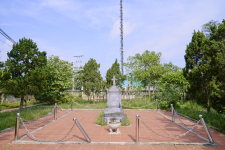
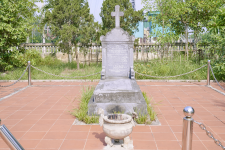
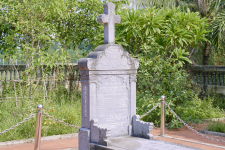
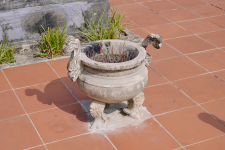
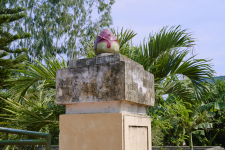
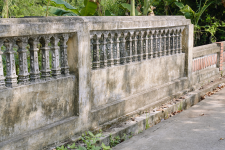
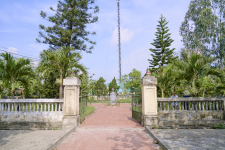
Camera tour
Price: Free
Time to visit a place: 60 phút
Open Time: 7:00 AM - Close Time: 6:00 PM
Address: Hung Trung Village, Hung Nguyen District, Nghe An Province
NGUYEN TRUONG TO TOMB – HUNG NGUYEN DISTRICT
In the late 19th century, when the Confucian class was engrossed in feudal thinking, Dai Nam country appeared a tendency to demand national renewal. Among them standed out a man with "a great education, great knowledge, great thought, great argument", all of which were associated with the history of thought and the history of Vietnamese culture in modern times. But his life was a tragedy of an unappreciated talent, to rest at the end of his life to keep the fields of his motherland. Although his life was short, but his virtue was mentioned for a long time, that was the Catholic intellectual Nguyen Truong To (1828 - 1871), born in Bui Chu village, Hung Trung commune, Hung Nguyen district, Nghe An province.
Being inherently intelligent, studying Chinese characters at village school and French at seminary school, and going directly to European countries to study and research, Nguyen Truong To soon became a learned intellectual in the world. With a deep sense of national pride and acquired advanced knowledge, Nguyen Truong To proposed that the way to save the country in Vietnam in the second half of the 19th century was to implement a multilateral foreign policy and open up the country, reform the country according to the way Emperor Meiji implemented in Japan. 58 reports – 58 programs of comprehensive reform and renewal of the country that Nguyen Truong To drafted and sent to Hue's court from 1863 to 1871 was to carry out that path of national salvation. But unfortunately, the stagnant conservatism, clinging to antiquated values, the personal interests of the scoundrels in Hue's court prevented Nguyen Truong To's efforts.
After the "reports" were hopeless, he retired to his hometown, recuperated, but still guided people to dig the Sat canal, which flows through Doai commune; designed and directed the construction of Doai church. In addition, he was also the author of the design and construction of the Chapel of Congregation of the Sisters of Saigon (1862 - 1863).
The old man's grave was only "earth-filled grave..." located in the middle of the village, buried at Da Mai lot (300m west of the present grave). Around 1941, Professor Nguyen Lan contributed money - including royalties to his book on Nguyen Truong To - and called on talented people (sages) and scholars in Vinh Association for Virtue Enlightenment contribute money to reburial near the village and set up a stone tomb, small but beautiful and friendly. In 1996, the tomb area was renovated spaciously as it is today.
The tomb is located on a high piece of land with an area of 1,062m2, surrounded by rice fields, village bamboo ramps, in front of Ke Gai canal, on the left is the massive Xa Doai church with a soaring bell tower, on the right is orchards full of orange and lemon trees, famous specialties of Nghe An.
The memorial work for Nguyen Truong To consists of 2 parts: Grave Garden and Tomb.
Although the grave garden is not large, it is embellished quite spaciously, with a brick fence surrounded by elegant white glazed porcelain pavilions. In the campus, the walkways are combined with red-fired bricks, interspersed with ornamental plants such as: pointed leaf tree (Araucariaceae), bascg, Plumeria, bamboo, ... and flower beds, making us feel like we are standing in a small, beautiful park keeping a quiet and peaceful countryside.
Nguyen Truong To's tomb is located in the East - West direction, made of Thanh Hoa green stone, structured in the shape of a rectangular box where his remains are located, the lower part of the tomb is made into 3 levels, carved with floral patterns, closed seals, the top of the tomb is shaped like a dome.
Attached to the grave is the head of the stele. The stele is made of monolithic green stone, has the appearance of an ancient stele but blends religious features: the cross is placed on the top of the stele, on the top of the stele is a semicircle, carved with dragon's head and water cloud patterns, flowers and leaves, around the stele are carved with images of apricot blossom, pomegranate flower, pen, letter book and 4 bats as if expressing his aspiration: Blessings were left to the descendants forever. The front and sides of the stele pillar are engraved with two parallel sentences in Han Nom characters praising the spirit of a man who respects God and loves his country very much.
Prominent in the front part of the stele is the text on the stele engraved with Quoc Ngu script, which summarized the biography and career praising Nguyen Truong To's intellect and talent along with his famous verse: “One step down, thousands of lives later still regret and repent it - When turning around, the fortune has turned into a hundred years”
On January 21, 1992, Ministry of Culture ranked Nguyen Truong To Tomb as a national relic in Decision No. 97/QD-VH.
Distance: 9.34 km
Distance: 9.79 km
Distance: 9.97 km
Distance: 10.42 km
Distance: 10.61 km
Distance: 11.25 km
Distance: 12.68 km
Distance: 12.71 km
Distance: 12.73 km
Distance: 4.09 km
Distance: 4.13 km
Distance: 9.84 km
Distance: 11.22 km
Distance: 11.44 km
Distance: 12.12 km
Distance: 12.15 km
Distance: 12.21 km
Distance: 12.27 km
Distance: 12.35 km
Distance: 12.68 km
Distance: 12.80 km
Distance: 12.98 km
Distance: 13.04 km
Distance: 13.05 km
Distance: 13.09 km
Distance: 13.11 km
Distance: 13.16 km
Distance: 0 m
Distance: 1.35 km
Distance: 1.88 km
Distance: 4.77 km
Distance: 5.95 km
Distance: 8.55 km
Distance: 8.84 km
Distance: 8.96 km
Distance: 9.01 km
Distance: 9.14 km
Distance: 9.19 km
Distance: 9.19 km
Distance: 9.28 km
Distance: 9.84 km
Distance: 10.17 km
Distance: 10.40 km
Distance: 10.56 km
Distance: 4.16 km
Distance: 4.31 km
Distance: 4.37 km
Distance: 7.16 km
Distance: 12.55 km
Distance: 12.57 km
Distance: 12.82 km
Distance: 13.05 km
Distance: 13.05 km
Distance: 13.07 km
Distance: 13.09 km
Distance: 13.33 km
Distance: 13.41 km
Distance: 13.59 km
Distance: 13.65 km



0
No Comment!